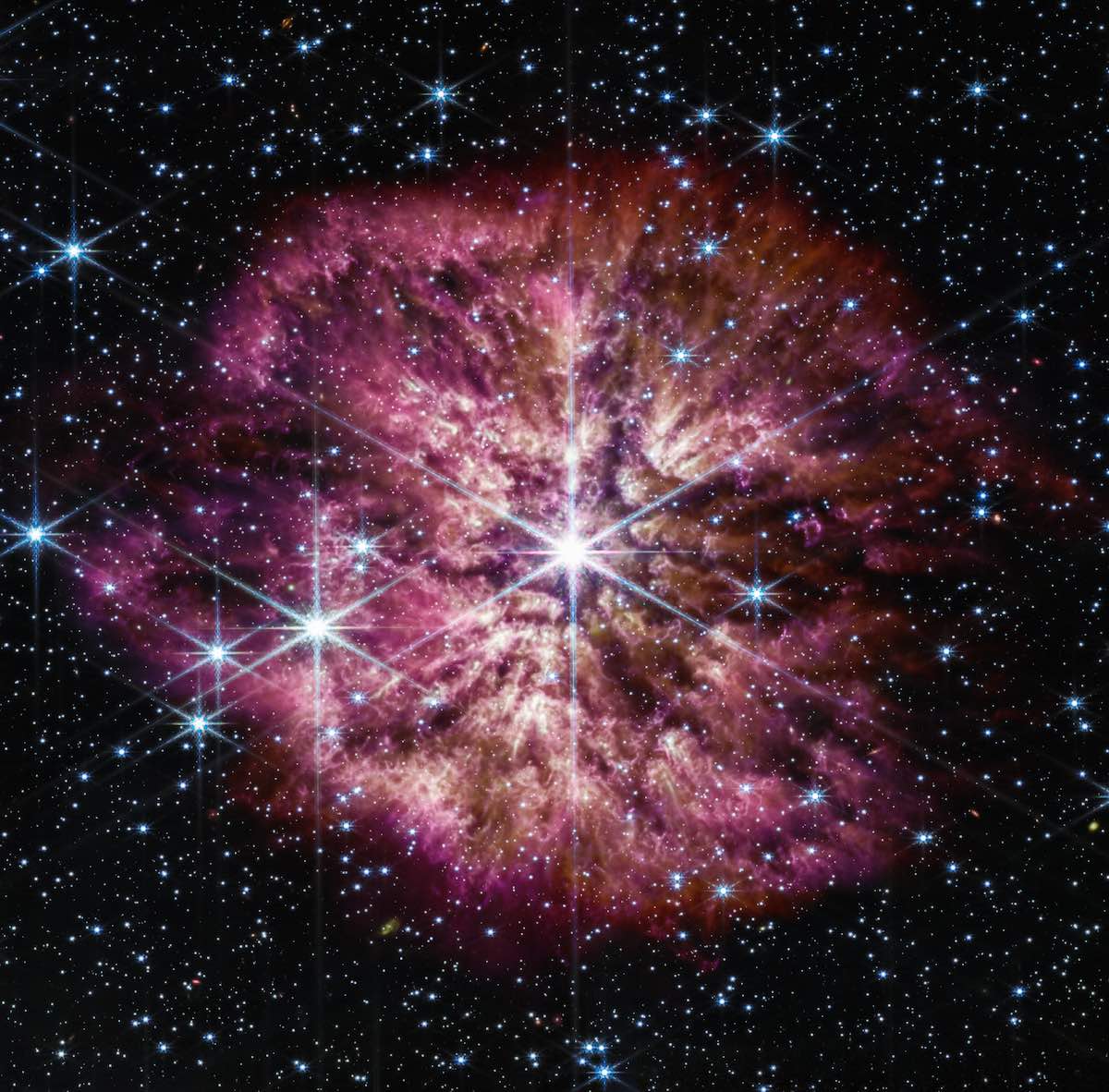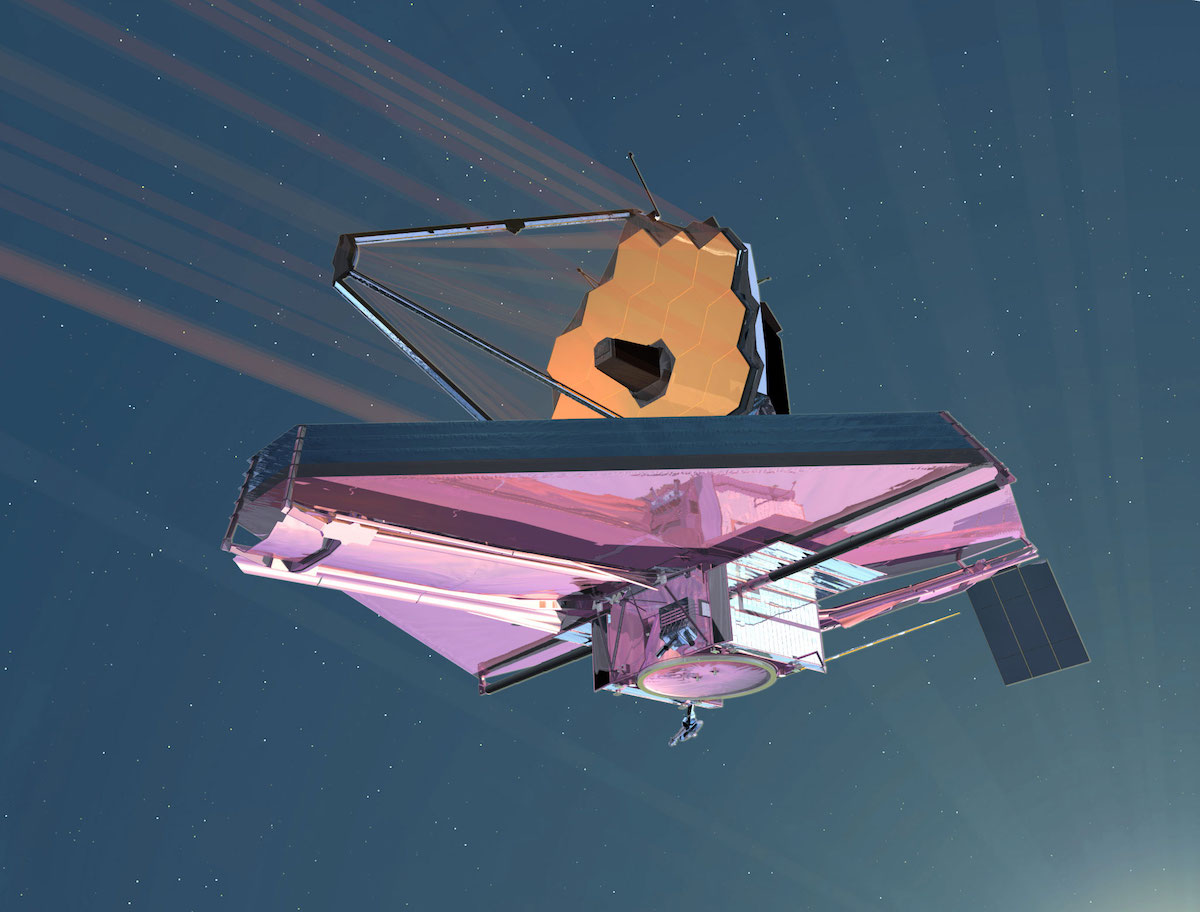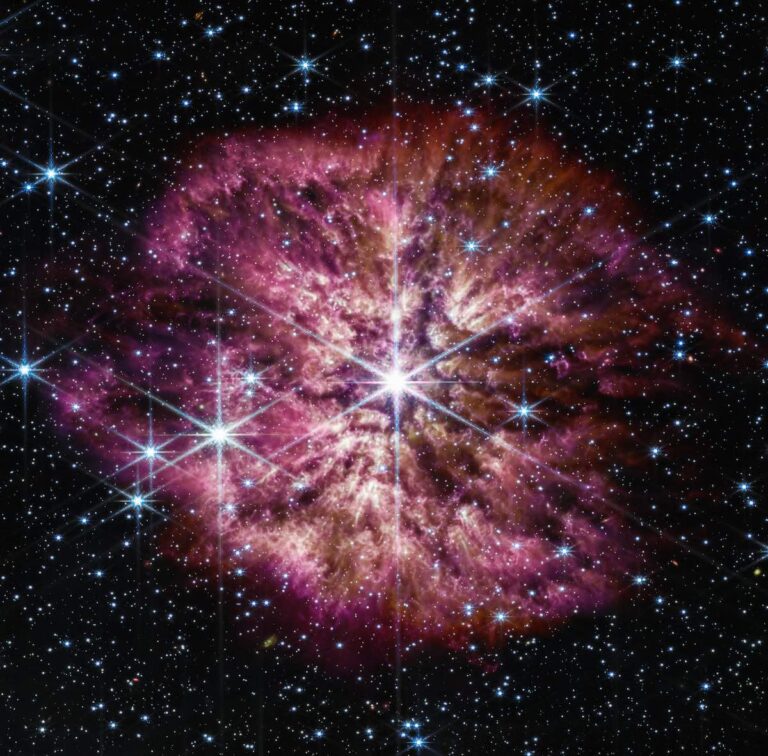
A new image from the James Webb Space Telescope shows a rare glimpse of a massive star 15,000 light-years away spewing a mixture of gas and dust, filling the cosmos with the elements necessary for the formation of other stars, planets, and life blocks.
The colorful scene captured by the Webb telescope combines observations from observatory instruments sensitive to different wavelengths of light in the near-infrared and mid-infrared parts of the spectrum. It shows a Wolf-Rayet star, a class of extremely hot, glowing stars that expel huge amounts of gas and dust from their outer layers before ending their lives in a supernova explosion.
Webb’s view of a star known as WR 124, located in the constellation Sagitta, shows a cloud of cooling gas as it flows away into interstellar space, the void between stars. Webb’s infrared instruments detect thermal emissions from gas and dust, material that is difficult to detect in visible-light observatories.
The glowing cloud of gas and dust surrounding WR 124 spans 10 light-years across.
“A history of past stellar mass episodes can be read in the structure of the nebula,” officials from the Space Telescope Science Institute, which operates Webb, wrote in a press release. “Instead of smooth shells, the nebula is formed from random, asymmetric ejections. Bright clumps of gas and dust appear like tadpoles swimming toward the star, with tails trailing behind them. , being blown back by the stellar wind.”
The star is 30 times the mass of the sun, and shed material equivalent to 10 days, according to NASA. Stars of that size can burn through their fuel in just a few hundred thousand years, a fraction of the roughly 10 billion year life span of a star like the sun.
Not all massive stars become Wolf-Rayet stars. Those that blast material into space that can later become molecules that help create new stars and planets.
“The origin of cosmic dust that can survive a supernova explosion and contribute to the overall ‘dust budget’ of the universe is of great interest to astronomers for several reasons,” the officials wrote in a NASA statement accompanying the new Webb image. “Dust is essential to the workings of the universe: It shelters forming stars, gathers to help form planets, and serves as a platform for molecules to form and cluster — including the building blocks of life on Earth.
“Despite the many important roles that dust plays, there is still more dust in the universe than can be explained by astronomers’ current theories of dust formation. The universe runs with an excess dust budget,” NASA said.

Webb’s large and sensitive instruments should yield new insights into how dust is created in the universe, especially in hard-to-see environments like Wolf-Rayet stars.
“Before Webb, dust-obsessed astronomers didn’t have enough detailed information to explore questions about dust production in environments like WR 124, and whether dust grains are large and abundant enough to survive. in the supernova and be a significant contribution to the total dust budget,” NASA said. “Now those questions can be investigated using real data.”
Observations of Wolf-Rayet stars can also inform astronomers about similar stars in the early universe shortly after the Big Bang. Astronomers believe that those stars all glowed together and consumed their stellar fuel in short, luminous lives, producing heavy elements like carbon, oxygen, and iron that spread out into the cosmos.
“Webb’s detailed image of WR 124 preserves forever a short, turbulent period of change, and promises future discoveries that will reveal long-hidden mysteries of cosmic dust,” NASA said.
After more than 20 years of design, development, assembly, and testing, the James Webb Space Telescope was launched on Dec. 25, 2021, aboard a European Ariane 5 rocket, and arrived in its operating orbit nearly a million miles (1.5 million). kilometers) from Earth about a month later. After launch, the observatory opened its glass and sunshield, allowing its instrument detectors to cool to cryogenic temperatures, not far above absolute zero.
Because of its extremely cold operating temperature, Webb’s detectors are sensitive enough to register faint light, or thermal energy, from distant stars and galaxies.
The $10 billion mission is a joint project developed by NASA, the European Space Agency, and the Canadian Space Agency.
Webb’s segmented primary mirror — with a diameter of 21.3 feet (6.5 meters) — is the largest ever placed in space. The mirror’s light-gathering power, combined with its sensitive, ultra-cold detectors, allows Webb to peer deeper into the universe — and farther into the past — than humans have ever seen before.
Email the author.
Follow Stephen Clark on Twitter: @StephenClark1.
